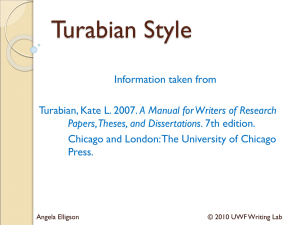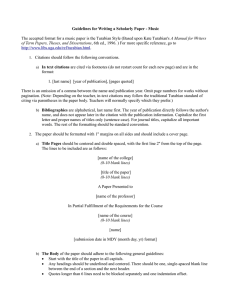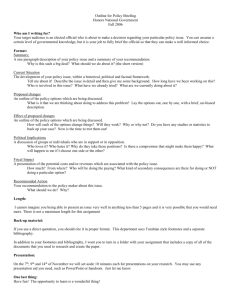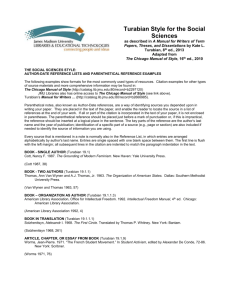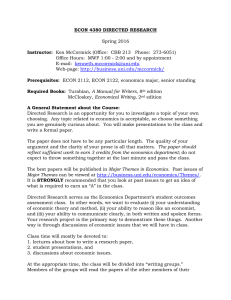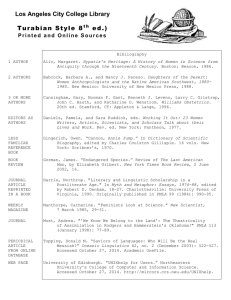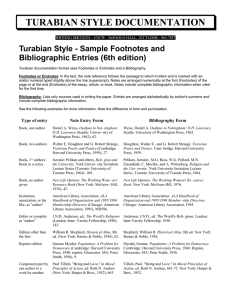using the apa style manual
advertisement
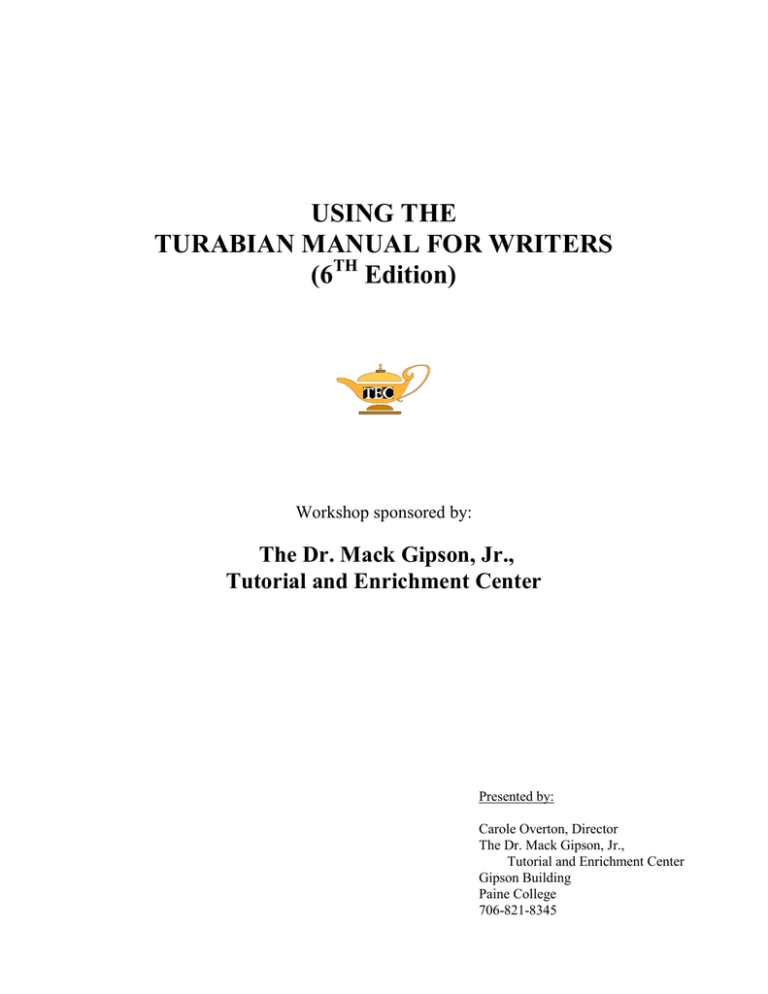
USING THE TURABIAN MANUAL FOR WRITERS (6TH Edition) Workshop sponsored by: The Dr. Mack Gipson, Jr., Tutorial and Enrichment Center Presented by: Carole Overton, Director The Dr. Mack Gipson, Jr., Tutorial and Enrichment Center Gipson Building Paine College 706-821-8345 WHAT IS "TURABIAN STYLE?" There are different sets of standard procedures (or rules for format) for writing research papers in different disciplines. For example, some disciplines use APA style and others use MLA style. One style which has been used for over 60 years is called “Turabian Style” because it was formalized by Kate Turabian at the University of Chicago. This style, interchangeable with the Chicago style, is often used for term papers and dissertations in the humanities, social sciences and natural sciences. When using any research style, it is important for you to follow the rules of that style very carefully. These rules cover such topics as format, grammar, typing rules, and page layout. It will be especially important for you to follow the rules for proper documentation (giving credit to those authors whose work you have referred to in your paper). Be sure to pay close attention to all details of the style. Your instructor has assigned you a research paper and has specified that you follow the Turabian style manual. This packet will discuss some of the more important features of that style and will provide samples of many of the rules. It is intended to be used as a brief guide to introduce you to the details of the Turabian style as you write your research paper. You will probably need more information as you go through the process. For more information, you should read A Manual for Writers of Term Papers, Theses, and Dissertations (Sixth Edition) by Kate L. Turabian.* Many other books may explain how to write a research paper. These books are available in the Tutorial and Enrichment Center and in most libraries and bookstores. In addition, many grammar books have sections on writing research papers. HOWEVER, keep in mind that the Turabian Manual will always be the best place to look for answers to your questions about format, rules, and procedures. Remember, also, that you will be using the rules for the 6th edition. If you want more information about any rules discussed in this packet, refer to the given section numbers of the Turabian Manual. (For example, section 5.30 refers you to chapter 5, section 30 in the Turabian Manual.) NOTES: * Turabian style offers choices for several different formatting techniques. This packet will suggest options that will satisfy your instructor’s requirements here at Paine College. However, the best advice is to be consistent: For example, if you type your title in capital and small letters, you should type all of your headings in the same manner. If you start out using footnotes instead of endnotes, you should use footnotes throughout your entire paper. Although most of the basic rules are presented in this packet, it was not possible to include all of the information needed to write your citations and reference entries. IN ORDER TO CORRECTLY WRITE YOUR CITATIONS AND REFERENCES, YOU WILL NEED TO REFER TO THE TURABIAN MANUAL ITSELF. This manual will be called the "Turabian Manual" or “Turabian” for the remainder of this packet. Dr. Mack Gipson, Jr., Tutorial and Enrichment Center, Paine College, Augusta, GA – Prepared by Carole D. Overton, Director Using the Turabian Manual for Writers – 6th Edition page 1 1 rev. 12/15/2011 web GENERAL TYPING RULES Paper Use standard paper (8½ X 11). Do not use erasable or onionskin paper. Do not tape, glue, or staple anything to any of the pages. Line Spacing o Double-space all basic text. o Single-space indented block quotations. o Single-space footnotes, itemized lists, and reference lists. Leave a blank line between notes, items, or entries. o Single-space the second line in a table of contents, table, illustration, or subheading if one of those lines runs over into a second line. Margins All margins (top, bottom, right, and left) should be at least 1". Paragraphs Use the TAB key to indent the first line of every margin so your indenting is consistent throughout the paper. Justification Use left justification. Do not hyphenate at the end of a line. o o Font Use a font that looks professional. Use font size 12 only. Page Numbering A paper written in Turabian style has 3 main parts. Each part has special rules for page numbering. (Refer to sections 1.4, 1.5, 1.7 – 1.47, and 14.6 – 14.9 of the Turabian Manual.) At Paine College, the following sections may be required. (Check with your instructor to find out what sections should be included in your paper): Section FRONT MATTER (PRELIMINARIES) TEXT (BODY) BACK MATTER (REFERENCE MATTER) Items Title Page Table of Contents List of Illustrations List of Tables Preface Abstract Introduction Part Chapter Section and Subsection Appendix Endnotes (if used in place of footnotes) Bibliography or Reference List Page Numbering Rules Lower case Roman numerals Center bottom of page Arabic numerals Center bottom of page with title Center top (or upper right hand corner) of all other pages of text Arabic numerals Center top (or upper right hand corner) NOTE: In all cases, the page number is typed in plain text by itself, without words or abbreviations. HINT: In order to have the page numbers appear in the proper places, you should insert a section break after the last page of your front matter and after each chapter. Then set up each section with a different first page so that your page number can be placed at the bottom of the first page of each chapter and at the top of the remaining pages of the chapter. Dr. Mack Gipson, Jr., Tutorial and Enrichment Center, Paine College, Augusta, GA – Prepared by Carole D. Overton, Director Using the Turabian Manual for Writers – 6th Edition page 2 2 rev. 12/15/2011 web HEADINGS 1) If the chapters are numbered: (1) Use Arabic numerals if possible. (2) Write the word Chapter followed by the number (Arabic numbers are preferred) on one line then skip a line before typing the chapter title: Chapter 2 Advantages of Computers 2) Headings and sub-headings are discussed in sections 1.36 – 1.38 and 14.10 – 14.12 of the Turabian Manual. Turabian style has 5 levels of headings. For most student papers, however, only 1 or 2 levels are usually needed. (See section 1.37 of the Turabian Manual.) In brief, the rules are as follows: a) Major headings start 2 inches from the top of the paper. Center the heading and type it in capital and lower case letters using bold, italics, or underlining. Do not use punctuation at the end of a chapter title. Do not use a heading for the first section, the introduction, of your paper. Here is a sample heading: Adult Reading Skills b.) Sub-headings should be centered but should be typed in plain text. Follow the same rules for capitalization that are described for main headings. All subheads begin on the third line below the previous section. (See section 14.10 of the Turabian Manual.) Here is a sample sub-heading: Workplace Literacy Dr. Mack Gipson, Jr., Tutorial and Enrichment Center, Paine College, Augusta, GA – Prepared by Carole D. Overton, Director Using the Turabian Manual for Writers – 6th Edition page 3 3 rev. 12/15/2011 web CREATING A WORKING BIBLIOGRAPHY As you start to do your research, it is a very good idea to keep track of the sources that you are using. If you write down all of the information you might need as soon as you see that you will be using a book or article, you will save yourself a lot of difficulty later on. The Turabian Manual will tell you the specific format to use for each of your resources, but the following lists will give you an idea of the kind of information you may need: BOOK (see Turabian Manual sections 11.3 – 11.38): Author’s full name: last name first (write down all names if there are more than one author) Full title (including any subtitle) Editor, compiler, or translator (include name and which job – ie. editor, compiler, etc.) Edition (if the book is a second or later edition) Name of series, if is part of a series, and number or name of this particular volume City of publication (write down only the first city if several are listed) Publisher Year of publication ARTICLE IN A SCHOLARLY JOURNAL (see Turabian Manual sections 11.39 – 11.40): Author’s name Title of the article Title of the journal Volume number (and issue number, if needed) Publication date Inclusive page numbers of the article (for example: 162 - 171) NEWSPAPER OR MAGAZINE ARTICLE (see Turabian Manual sections 11.41, 11.44, 11.45): Author’s name Title of the article Title of the periodical Volume number (and issue number, if needed) Date of publication Inclusive page numbers of the article. If the article appears on discontinuous pages, write down all of the pages. PUBLIC DOCUMENTS (see Turabian Manual sections 12.1 – 12.33): Name of country, state, city, town, or other government district Name of legislative body, court, executive department, bureau, board, commission, etc. Name of office Name of division, regional office, etc. (the “author”) Title of document The remaining information needed depends on type of document (see Manual for details) NOTE: For an Internet source, include the complete pathname and the date of access. Dr. Mack Gipson, Jr., Tutorial and Enrichment Center, Paine College, Augusta, GA – Prepared by Carole D. Overton, Director Using the Turabian Manual for Writers – 6th Edition page 4 4 rev. 12/15/2011 web REFERENCES/CITATIONS IN TEXT: FOOTNOTES VS. ENDNOTES It is your choice whether to use footnotes or endnotes in your paper. This packet will briefly cover both methods. For more information, refer to the Turabian Manual sections 8.7-8.13. Footnotes are like endnotes in several ways: Both use superscript numbers to identify each note/quotation/idea that has to be cited. Both use exactly the same format for the citation information (the notes). Both restart their numbering with each new chapter. Footnotes are different from endnotes in one important way: Footnotes appear at the bottom of the page where the quotation or idea is used, separated from the text by a short line called the separator. Endnotes appear as a separate part of the Appendix of the paper. See pages 11-12 of this packet for samples of each method. IDEAS THAT ARE NOT YOUR OWN When you use ideas that are not your own, you must give credit to the source even if you put those ideas in your own words. Use the appropriate format for footnotes or endnotes (whichever method you are using). According to Turabian, footnotes are preferable to endnotes if the paper is going to be put on microfilm.4 4 Turabian, Kate L., A Manual for Writers of Term Papers, Theses, and Dissertations (Chicago: University of Chicago Press, 1996), 118. SHORT DIRECT QUOTATIONS (refer to Turabian section 5.4) If you are using a short quotation (fewer than 8 lines of type), you should incorporate it into your text and use double quotation marks before and after it. Using the appropriate format for footnotes or endnotes (whichever method you are using), you must number the quote and record the relevant information about the source of the quotation. Put the period after the last word of the quotation but before the end quotation marks and the note number. Turabian stresses that writing a research paper includes “the responsibility to give proper acknowledgement whenever one is indebted to another for either words or ideas.” 5 5 Ibid., 74. Dr. Mack Gipson, Jr., Tutorial and Enrichment Center, Paine College, Augusta, GA – Prepared by Carole D. Overton, Director Using the Turabian Manual for Writers – 6th Edition page 5 5 rev. 12/15/2011 web LONG DIRECT QUOTATIONS (BLOCK QUOTATIONS) (refer to Turabian section 5.4 and 5.30+) When you type a direct quotation that is 2 or more sentences long and runs to 8 or more lines of type, you should treat it as a long quotation. Do not use quotation marks around a long quotation; instead single-space the quotation and indent every line 4 spaces from the left margin. When the quotation begins with a paragraph in the original source, you must indent the first line of the quotation 8 spaces. In most cases, however, the first line does not get this special indentation. The period to end the quotation is typed after the last word of the quotation and is followed by the footnote number. The Turabian Manual provides some background information on the origins of the publication and the important role played by Kate Turabian herself: In fact, Kate Turabian worked for over thirty years at the University of Chicago, where she was dissertation secretary from 1930 to 1958. She died in 1987 at age ninety-four, a few months after publication of the fiftieth anniversary edition of her manual. Commenting on the more than eleven thousand theses and dissertations she inspected for the university, she told the Chicago Tribune, “I learned early that modern young people have ideas of their own on grammar and punctuation.” It was to correct and guide these ideas that she wrote the instruction sheets that were given to graduate students at the university. She later adapted materials from the Press’s Manual of Style to expand the guidelines into a sixty-eight page booklet, copyrighted by the University of Chicago in 1937 and distributed first by the campus bookstore, then by the Press.8 8 Turabian, A Manual, vii. Ibid. (refer to Turabian sections 8.85 – 8.96) If you have more than one footnote or endnote from the same source, you may be able to use a shortened form of the citation information in your notes: 1. If you use the same source for two consecutive notes, you may use the term Ibid. instead of repeating the author, title, and publishing information. You must give the page number, however, if the second citation came from a different page than the first. (Refer to the sample notes under the “Ideas” and “Short Quotation” sections above.) 4 Note #4 Turabian, Kate L., A Manual for Writers of Term Papers, Theses, and Dissertations (Chicago: University of Chicago Press, 1996), 118. 5 Note #5 Ibid., 74. 2. If the two notes from a source do not appear consecutively (in other words, if there is at least one other note between the two), then you must use a shortened reference form for the second and following notes from the source. The shortened form usually gives the author’s last name, a shortened form of the title of the book, chapter, or article, and the page number: 4 Note #4 Turabian, Kate L., A Manual for Writers of Term Papers, Theses, and Dissertations (Chicago: University of Chicago Press, 1996), 118. 8 Note #8 Turabian, A Manual, 80. Dr. Mack Gipson, Jr., Tutorial and Enrichment Center, Paine College, Augusta, GA – Prepared by Carole D. Overton, Director Using the Turabian Manual for Writers – 6th Edition page 6 6 rev. 12/15/2011 web TITLE PAGE Include all of the necessary information. Set your computer on double-spacing. Press the Enter key several times to get the spacing between the different sections of your title page. A Study of Trends in the Political Climate at Paine College A Research Project The date you type on the cover page should be the date the paper will be submitted. Presented to the Faculty of the History and Political Science Department In Partial Fulfillment of the Requirements for Graduation Major Professor: Dr. Gloria Williams-Way By Ima T. Student April 1, 2007 NOTE: The samples on the following pages are based on the samples in the Turabian Manual, pages 256 – 281. The samples printed in that manual have been modified for this packet, however, to show the format that Paine College students should use when typing their research papers. Please note that the samples come from several different research papers and represent several different topics; they should not be viewed as parts of the same paper. Dr. Mack Gipson, Jr., Tutorial and Enrichment Center, Paine College, Augusta, GA – Prepared by Carole D. Overton, Director Using the Turabian Manual for Writers – 6th Edition page 7 7 rev. 12/15/2011 web TABLE OF CONTENTS Number the Table of Contents pages with lower case Roman numerals, centered at the bottom of the page. Contents List of Illustrations............................................................................................... iii List of Tables ....................................................................................................... iv Use capital and small letters (title case) when typing the table of contents. Set a tab with a dot leader to type the row of dots from the end of your entry to the page number on the right-hand side. Abstract ............................................................................................................... v Chapter 1. Introduction .................................................................................................... 1 Goals of the Study Part I. Overview 2. Policy Divergence and Traditional Research ................................................. 5 Background of a Contrast: Divergence of Long-Term Care Outputs in Rural and Industrial States The Contrast and Its Causes Traditional Studies and the Failure to Provide a Plausible Explanation 3. Methodology, Research Paradigms, and the Analytic Frameworks Governing Basic Assumptions .......................................................................................... 20 Rationale for the Search Method Empirical Data and Their Collection Data Analyses Two Analytic Models Basic Assumptions A Dynamic View of the State Health Delivery System Part II. The Rural Case Study 4. The Cost-Recovery Process in Rural States .................................................... 36 Why Health Delivery Costs Rose during the 1980s Why Rural States Needed to Act How Recipients of Health Care in Rural States Were Compensated i Dr. Mack Gipson, Jr., Tutorial and Enrichment Center, Paine College, Augusta, GA – Prepared by Carole D. Overton, Director Using the Turabian Manual for Writers – 6th Edition page 8 8 rev. 12/15/2011 web LIST OF ILLUSTRATIONS and LIST OF TABLES These two pages are set up in exactly the same way. The only difference is the heading typed at the top of the page: Type the word Illustrations at the top of the page that lists the illustrations in your paper, and type the word Tables at the top of the page that lists the tables included in your paper. Number the Illustrations page and the Tables page with lower case Roman numerals centered at the bottom of the page. Use capital and small letters (title case) when typing the names of the illustrations or tables. Set a tab with a dot leader to type the row of dots from the end of your entry to the page number on the right-hand side. Illustrations Figure Page 1. Paul Gauguin, Lutte de Jacob avec l’ange, 1888 ........................................... 1 2. Jean Beraud, The Church of Saint-Philippe-du-Roule, 1877 ......................... 7 3. Jean Baptiste Edouard Detaille, En reconnaissance, 1876............................. 11 4. William Adolphe Bouguereau, Bathers, 1884 ................................................ 13 iii Refer to Turabian sections 1.19 – 1.23 and 14.21 for information about the list of illustrations and to sections 1.24 and 14.22 for information about the list of tables. Tables Table Page 1. Principal Ceramic Industries .......................................................................... 4 2. Ceramic Bodies and Their Characteristics ..................................................... 5 3. Chronological Sequence of Developments in Pottery and Ceramic Technology ............................................................................................... 7 4. Relation between Pottery Making and Sedentism among Fifty-nine Societies ................................................................................................... 9 iv Dr. Mack Gipson, Jr., Tutorial and Enrichment Center, Paine College, Augusta, GA – Prepared by Carole D. Overton, Director Using the Turabian Manual for Writers – 6th Edition page 9 9 rev. 12/15/2011 web PREFACE A preface gives you a place to explain the reason(s) for the study, discuss the background and scope of the project, and present your purpose for writing. You may or may not need to include a preface in your paper. If you do include a preface, number the page with a lower case Roman numeral typed in the center at the bottom of the page. Refer to Turabian section 1.25 for more information. ABSTRACT The abstract gives a synopsis of your paper and tells the reader about your sources. It should consist of 2 paragraphs: The first paragraph briefly summarizes your thesis, main points, and conclusions. The second paragraph tells the reader about the types of sources you used in writing the paper. The paragraphs in the abstract should be typed as regular paragraphs, with the first line of each paragraph indented by using the TAB key. The page number will be a lower case Roman numeral typed in the center at the bottom of the page. Refer to Turabian section 1.32 for more information HINTS FOR FINDING FORMATS FOR NOTES AND BIBLIOGRAPHY ENTRIES The Turabian Manual gives many specific examples of the formats for notes and for bibliography entries but the structure of the book may cause some confusion until you become familiar with it. The following chart may help you to understand how the book is organized: Chapter 8 9 10 11 Title Notes Bibliography Parenthetical References and Reference Lists Comparing the Two Documentation Systems Purpose Explains how to write your footnotes or endnotes. Gives specific examples. Look at the listing on pages 116-117 to find out which patterns to consider. Explains how to organize and type the bibliography page. PAINE COLLEGE PROFESSORS DO NOT USE THE PARENTHETICAL STYLE FOR TURABIAN PAPERS. DO NOT USE THIS CHAPTER. Gives the proper format for notes, parenthetical references, and bibliography page. All 4 patterns are given for each type of situation, indicated by the letters N (notes), B (bibliography), PR (parenthetical reference) and RL (reference list). You should use the Notes (N) and Bibliography (B) formats. Look at the listing on pages 185-187 to find out which patterns to consider. Dr. Mack Gipson, Jr., Tutorial and Enrichment Center, Paine College, Augusta, GA – Prepared by Carole D. Overton, Director Using the Turabian Manual for Writers – 6th Edition page 10 10 rev. 12/15/2011 web CHAPTERS: SAMPLE WITH FOOTNOTES If your introduction is not too short, you can call it Chapter 1. Otherwise, just call it Introduction. Chapter 2 The Economy of Nature The search for an exact expression of economic principles naturally led No matter what you call it, it is considered part of the body of your paper and it starts on page 1 of the paper. Each chapter will start on a new page following the end of the previous chapter. In the sample on this page, chapter 1 ended on page 4 so this chapter starts on page 5. Locke to the mathematical school of the nineteenth-century economists represented by Augustin Cournot, Leon Walras, Hermann Heinrich Gossen, and William Stanley Jevons.1 These were a school not in the sense of following the same program, but in that they independently explored the use of mathematics in economic analysis. It was to Jevons’ The Theory of Political Economy that Locke turned for his principal model, adding a few modifications culled from the early work of Vilfredo Pareto.2 Viewing economics as analogous to the physical science dealing with statics and equilibrium, Jevons tried to develop a program of scientific economics from Bentham’s doctrine, creating out of the combination a “calculus of pleasure and pain.”3 Herbert Spencer, also following the utilitarian tradition, had meanwhile framed __________ The notes for each chapter will start with number 1. If you use footnotes, there will be no confusion since the notes will appear on the same page as the information. If you use endnotes, you will identify each chapter before you type the notes. (Refer to sample ENDNOTES on the next page of this packet.) The computer can help you number your footnotes/endnotes. Make use of its capabilities. Refer to Turabian section 1.34 for more information. 1 C. Gide and C. Rist, A History of Economic Doctrines, 2d ed. (London: George C. Harrap, 1948), 499-514. 2 William Stanley Jevons, The Theory of Political Economy, 2d ed. Rev. (London: Macmillan, 1879). Lotka used the 1911 edition, which has the same text. Also Vilfredo Pareto, Manual of Political Economy, trans. A. S. Schwier (New York: Augustus M. Kelly, 1971). 3 Jevons, Political Economy, vii. 5 Dr. Mack Gipson, Jr., Tutorial and Enrichment Center, Paine College, Augusta, GA – Prepared by Carole D. Overton, Director Using the Turabian Manual for Writers – 6th Edition page 11 11 rev. 12/15/2011 web CHAPTERS: SAMPLE WITH ENDNOTES For Paine College papers, the endnotes endnotes for each chapter will appear after the last page of that chapter. The endnotes pages will be numbered with Arabic numerals at the top right corner of each page. Chapter 2 The Economy of Nature The search for an exact expression of economic principles naturally led Locke to the mathematical school of the nineteenth-century economists represented by Augustin Cournot, Leon Walras, Hermann Heinrich Gossen, and William Stanley Jevons.1 These were a school not in the sense of following the same program, but in that they independently explored the use of mathematics in economic analysis. It was to Jevons’ The Theory of Political Economy that Locke turned for his principal model, adding a few modifications culled from the early The notes for each chapter will start with number 1. Type the chapter number as a header above the first note for that chapter (see sample on this page). Each note number should be full-sized and followed by a period. The notes for all chapters will appear in one continuous list, with the chapter numbers serving as headers to identify the group of notes from that chapter. Refer to Turabian sections 1.46 and 14.38 for more information. work of Vilfredo Pareto.2 Viewing economics as analogous to the physical science dealing with statics and equilibrium, Jevons tried to develop a program of scientific economics from Bentham’s doctrine, creating out of the combination a “calculus of pleasure and pain.”3 Herbert Spencer, also following the utilitarian tradition, had meanwhile framed 5 15 Notes Chapter Two 1. C. Gide and C. Rist, A History of Economic Doctrines, 2d ed. (London: George C. Harrap, 1948), 499-514. 2. William Stanley Jevons, The Theory of Political Economy, 2d ed. Rev. (London: Macmillan, 1879). Lotka used the 1911 edition, which has the same text. Also Vilfredo Pareto, Manual of Political Economy, trans. A. S. Schwier (New York: Augustus M. Kelly, 1971). 3. Jevons, Political Economy, vii. Dr. Mack Gipson, Jr., Tutorial and Enrichment Center, Paine College, Augusta, GA – Prepared by Carole D. Overton, Director Using the Turabian Manual for Writers – 6th Edition page 12 12 rev. 12/15/2011 web BIBLIOGRAPHY Use the word Bibliography as the header for the list of sources used in writing your paper. Your sources must be written in the appropriate format. You will have to refer to the Turabian Manual chapters 9 – 12 for details on specific formats. All sources should be alphabetized in one continuous list. Notice that each entry starts at the left margin. If more than one line is needed, the succeeding lines are single-spaced and are indented. You must double-space between entries, however. Refer to Turabian sections 1.47 and 14.3914.42, as well as chapters 9 and 10, for more information. 20 Bibliography Downer, Alan S. “Prolegomenon to a Study of Elizabethan Acting.” Maske and Kothurn 10 (1965): 625-36. Harbage, Alfred. Shakespeare and the Rival Traditions. New York: Macmillan, 1952. Hillebrand, Harold Newcomb. The Child Actors: A Chapter in Elizabethan Stage History. Urbana: University of Illinois Press, 1926. Hodges, C. Walter. The Globe Restored. London: E. Benn, 1953. King, T. J. “Staging of Plays at the Phoenix in Drury Lane, 1617-42.” Theatre Notebook 19 (1965):1466-68. Lithicum, M. Channing. Costume in the Drama of Shakespeare and His Contemporaries. Oxford: Clarendon Press, 1936. Dr. Mack Gipson, Jr., Tutorial and Enrichment Center, Paine College, Augusta, GA – Prepared by Carole D. Overton, Director Using the Turabian Manual for Writers – 6th Edition page 13 13 rev. 12/15/2011 web MISCELLANEOUS SUGGESTIONS 1. Avoid gender-specific terms (like "he" and "she"). 2. Make sure you have subject-verb agreement. 3. Be consistent in your use of verb tenses. 4. Use proper punctuation. 5. Be sure to back up your paper onto an extra flash drive in case your main drive develops a problem. Make a hard copy after you finish each draft. 6. Make sure your final copy is legible. 7. Make sure your final copy is neat. Avoid smudges, erasures, crossed-out words, and insertions. 8. Make sure each page is numbered and in order before you assemble and hand in your paper. (Ask your instructor if you should just staple you paper together or if you must use a report cover.) 9. Keep a copy of your final paper for your own protection and for your records. 10. Give proper credit to ideas as well as direct quotations. Your instructor will be able to tell when you are not using your own ideas (or your own words) and will look for your citation to see where you found the information. 11. Be sure to integrate your sources into your paper and synthesize what they have said. Do not merely report what each person wrote. Do not turn your paper into a book report on each article. Remember: You must put your own thoughts into this paper and you must find a way to incorporate what other people have written. 12. There are a number of websites that may help you understand how to use Turabian style. A few are listed below: www.chicagomanualfostyle.org www.libs.uga.edu/ref/Turabian.html http://writing.colostate.edu/references/sources/Chicag o www.norman.lib.uconn.edu owl.english.purdue.edu www.dianahacker.com/resdoc 13. Presents frequently asked questions about the style University of Georgia Library Colorado State University Writing Center University of Connecticut Library Purdue University Writing Center Site prepared by author of several textbooks on reference procedures The sites listed above seem to be helpful, but be aware that few if any of these sites will give as much information or as many different reference formats as the Turabian Manual itself. Therefore, it is probably best to refer to the manual itself when preparing your paper. Dr. Mack Gipson, Jr., Tutorial and Enrichment Center, Paine College, Augusta, GA – Prepared by Carole D. Overton, Director Using the Turabian Manual for Writers – 6th Edition page 14 14 rev. 12/15/2011 web
